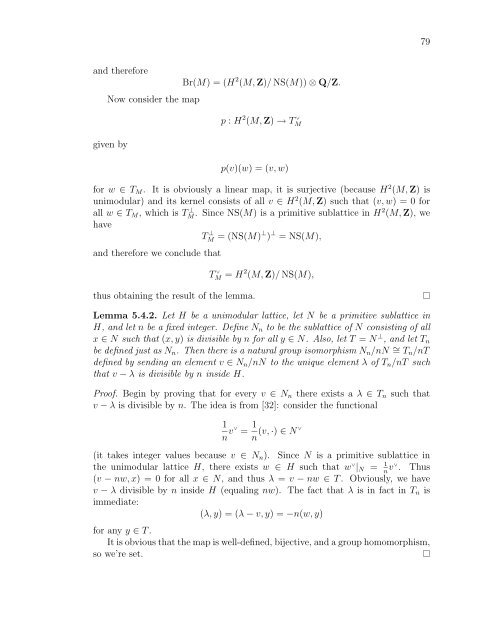derived categories of twisted sheaves on calabi-yau manifolds
derived categories of twisted sheaves on calabi-yau manifolds
derived categories of twisted sheaves on calabi-yau manifolds
Create successful ePaper yourself
Turn your PDF publications into a flip-book with our unique Google optimized e-Paper software.
and therefore<br />
Now c<strong>on</strong>sider the map<br />
given by<br />
Br(M) = (H 2 (M, Z)/ NS(M)) ⊗ Q/Z.<br />
p : H 2 (M, Z) → T ∨<br />
M<br />
p(v)(w) = (v, w)<br />
for w ∈ TM. It is obviously a linear map, it is surjective (because H 2 (M, Z) is<br />
unimodular) and its kernel c<strong>on</strong>sists <str<strong>on</strong>g>of</str<strong>on</strong>g> all v ∈ H 2 (M, Z) such that (v, w) = 0 for<br />
all w ∈ TM, which is T ⊥ M . Since NS(M) is a primitive sublattice in H2 (M, Z), we<br />
have<br />
T ⊥ M = (NS(M) ⊥ ) ⊥ = NS(M),<br />
and therefore we c<strong>on</strong>clude that<br />
thus obtaining the result <str<strong>on</strong>g>of</str<strong>on</strong>g> the lemma.<br />
T ∨<br />
M = H 2 (M, Z)/ NS(M),<br />
Lemma 5.4.2. Let H be a unimodular lattice, let N be a primitive sublattice in<br />
H, and let n be a fixed integer. Define Nn to be the sublattice <str<strong>on</strong>g>of</str<strong>on</strong>g> N c<strong>on</strong>sisting <str<strong>on</strong>g>of</str<strong>on</strong>g> all<br />
x ∈ N such that (x, y) is divisible by n for all y ∈ N. Also, let T = N ⊥ , and let Tn<br />
be defined just as Nn. Then there is a natural group isomorphism Nn/nN ∼ = Tn/nT<br />
defined by sending an element v ∈ Nn/nN to the unique element λ <str<strong>on</strong>g>of</str<strong>on</strong>g> Tn/nT such<br />
that v − λ is divisible by n inside H.<br />
Pro<str<strong>on</strong>g>of</str<strong>on</strong>g>. Begin by proving that for every v ∈ Nn there exists a λ ∈ Tn such that<br />
v − λ is divisible by n. The idea is from [32]: c<strong>on</strong>sider the functi<strong>on</strong>al<br />
1<br />
n v∨ = 1<br />
∨<br />
(v, ·) ∈ N<br />
n<br />
(it takes integer values because v ∈ Nn). Since N is a primitive sublattice in<br />
the unimodular lattice H, there exists w ∈ H such that w∨ |N = 1<br />
nv∨ . Thus<br />
(v − nw, x) = 0 for all x ∈ N, and thus λ = v − nw ∈ T . Obviously, we have<br />
v − λ divisible by n inside H (equaling nw). The fact that λ is in fact in Tn is<br />
immediate:<br />
(λ, y) = (λ − v, y) = −n(w, y)<br />
for any y ∈ T .<br />
It is obvious that the map is well-defined, bijective, and a group homomorphism,<br />
so we’re set.<br />
79
















